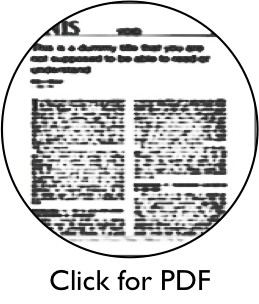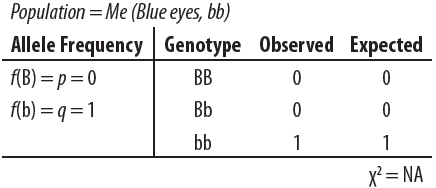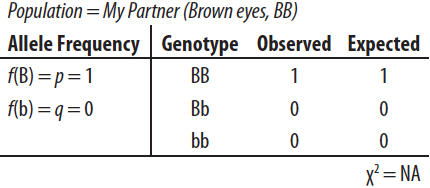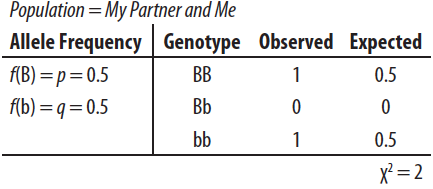
Tweet
April 23, 2015
Proceedings of the Natural Institute of Science | Volume 2 | SOFD 3
I am in Hardy-Weinberg Equilibrium
J. Jones1
1 - Umm, I work at home

Introduction
The Hardy-Weinberg law, developed independently in 1908 by G. H. Hardy and Wilhelm Weinberg, states that the frequencies of genes and genotypes in a population remain constant in the absence of external forces (such as mutation, natural selection, genetic drift, or migration). A population is said to be in Hardy-Weinberg Equilibrium (HWE) when its genotype frequencies do not significantly differ from the predictions given by the Hardy-Weinberg mathematical model. Deviation from HWE suggests some evolutionary influence on the population.
I have recently become engaged to my partner of 1+ years. In anticipation of our civil union, we have decided to complete various tests to ensure our compatibility and health including drug tests, fertility tests, STD tests and background checks. My partner has also requested that before we join in harmonious union and potentially mate, I check that I fulfill the requirements of HWE, and that together, as a population of 2, we are also in solid HWE. [Note: publication of this paper was not part of my partner’s request. I just felt I needed to pad my publication record a bit.]
The goal of this paper is to determine if I am indeed in HWE. Additionally, I test my partner’s HWE as well as our HWE as a couple.
Methods
The trait I chose to test for HWE was eye color. According to various biology textbooks (Moore and Slusher 2004, Stone 2004, Sadava et al. 2011), eye color follows a simple Mendelian inheritance pattern and is a literal textbook example of HWE. It actually shouldn’t be, though; eye color is a polygenic, quantitative trait (Duffy et al. 2007). However, my partner is marrying me for my HWE potential and not my biological savvy, so we’ll just move on.
Blue eyes are said to be the recessive eye color. A person with blue eyes can be described as having two copies of a ‘b’ allele (i.e., bb). Brown eyes are the dominant eye color and a person with brown eyes will have either two copies of a ‘B’ allele (i.e., BB), or one ‘B’ copy and one ‘b’ copy (i.e., Bb).
HWE states that the frequency of BB genotypes in a population is equal to p2, the frequency of Bb genotypes is equal to 2pq, and the frequency of bb genotypes is equal to q2. The parameters p and q refer to the frequency of the B and b alleles, respectively. From the values of p and q given by observed data (e.g., my eye color), one can derive expected frequencies of BB, Bb, and bb genotypes and test the significance of any deviations from the expected frequencies using a chi-square (χ2) test. Or, you could just input our data into an online HWE calculator. Which I did. This one.
Results
I have blue eyes, therefore my genotype for eye color is bb. Thus, p = 0.0 and q = 1.0. The expected genotypes are then: BB = 0, Bb = 0, bb = 1. Table 1 gives the results of a χ2 analysis comparing observed and expected eye color.

The χ2 statistic is actually unable to be calculated, but since the observed data exactly matches the expected data, I conclude that I am in HWE.
My partner has brown eyes and thus has a genotype that could be either BB or Bb. My partner is a pretty dominant person (for instance, this person made me eat tofu once) and my partner’s eyes are really, really gorgeously brown, so I will assume the genotype is BB. This gives p = 1.0 and q = 0.0, and the expected genotypes as BB = 1, Bb = 0, and bb = 0. See Table 2 for the χ2 analysis.

Again, the χ2 statistic cannot be calculated, but as the observed data are identical to the expected data, I conclude that my partner is in HWE.
Taken as a population of two, our allele frequencies are p = 0.5 and q = 0.5, and our expected genotypes are BB = 0.5, Bb = 1.0, and bb = 0.5. Table 3 gives the χ2 results.

The χ2 statistic is 2.0, which is less than the critical χ2 value of 3.84 (1 degree of freedom, P = 0.05). Thus, together, we are in HWE.
Discussion
The data suggests that separately we are in HWE and that together we are in HWE. Thus, based on this critical criterion, we are ready for our upcoming civil union. I suppose it would have been more romantic if separately we weren’t in HWE but upon coming together we achieved HWE. But, then again, maybe not, because you wouldn’t be saying the same thing about STDs.
Incidentally, random mating within the population is an assumption that must be met before the HWE can be applied. Speaking for myself, my previous matings could definitely be described as ‘random’ (especially considering that I’ve been to Burning Man, I swear). My partner, on the other hand, has coyly denied discussing their sexual past, so further research is required to see if this assumption was met.
Eye color is just one of thousands of potential traits for which to determine HWE. However, in the course of this research, I’ve realized that any trait, no matter their underlying genotype, would attain HWE as long as the population size equals 1. This suggests that everyone is in their own personal HWE. G.H. Hardy was in HWE. Wilhelm Weinberg was in HWE. Every anti-evolutionist is in HWE. Even God (or any deity), as a person, is in HWE. You may be alone, but at least you are in HWE.
Moreover, any two persons would automatically be in HWE, regardless of their genotype frequency. So, Abbot & Costello, Mary & Joseph, any Israelite & Palestinian, and even God & Satan (again, as persons), would be in HWE.
In fact, automatic HWE extends to a maximum group size of 3. There may not be a better reason for polyamory than the fact that no matter who the third person is, they’d all still be in HWE. However, any group larger than 3 runs the risk of violating HWE. Sorry, Fred.
Conclusion
I am in Hardy-Weinberg Equilibrium, as is my partner, and as is our union. It will stay that way in good times and in bad, for richer for poorer, in sickness or good health and until death do us part. In fact, there is only one thing that can disrupt our HWE: having two or more kids.

Proceedings of the Natural Institute of Science (PNIS) by https://instsci.org/ is licensed under a Creative Commons Attribution-ShareAlike 4.0 International License.